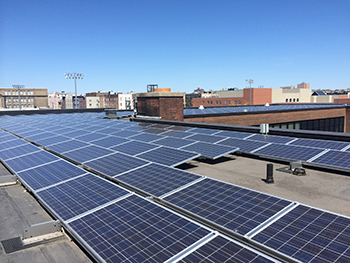Q&A: Back to School with Solar
 In 2014, a number of stakeholders in the solar industry came together to create the National Solar Schools Consortium. The organization acts as a unified voice for the growing national solar schools movement, with a goal of achieving 20,000 solar installations at schools and universities, 200 school districts with solar schools initiatives and 2,000 member organizations by 2020.
In 2014, a number of stakeholders in the solar industry came together to create the National Solar Schools Consortium. The organization acts as a unified voice for the growing national solar schools movement, with a goal of achieving 20,000 solar installations at schools and universities, 200 school districts with solar schools initiatives and 2,000 member organizations by 2020.
As of September 2014, there were more than 3,700 solar energy systems located on public and private K-12 schools in the U.S., according to a report released by The Solar Foundation. The solar movement is becoming so strong that now new construction projects integrate solar into part of the initial plan, as opposed to retrofitting schools to include solar. School Construction News spoke with Jim Rice, CEO of Nautilus Solar Energy LLC, a Summit, N.J.-based company that delivers full-service expertise on solar electric projects across the U.S., about the future of solar power at schools for the upcoming school year.
Q: Why are schools starting to go solar?
Rice: Nautilus Solar was founded in 2006, and schools were some of the early adopters for a couple of key reasons. It all comes down to the almighty buck. Our core value that we provide schools is the ability to save them costs on their power bills. School infrastructure is always a challenge, so we’re investing in the infrastructure and then saving them money.
Another reason is that they have broader social purpose, and they all have sustainability goals. Because schools serve as key elements in the community, the idea is that they’re promoting sustainability, and then saving money is big proponent.
The last reason is educational. The ability to have a solar system and then teach a curriculum around it is a real benefit for schools. We developed a K-12 curriculum for schools, and many found value in it.
Q: Are there specific areas of the country where solar is more popular for schools, and why?
Rice: The top five areas are California, New Jersey, Arizona, Massachusetts and Nevada. In all of them, the amount of solar resource is good. They also have a supportive regulatory environment, and that combination means that they are tremendous targets for solar. What’s even more exciting is if you look at the list of schools that can save money, the list goes way beyond those states.
Q: How does going solar affect maintenance and operations at a school?
Rice: If the system is on the roof, you have to make sure the roof is high enough quality and strong enough to hold a solar facility. The good news is that systems have gotten better and lighter. If they’re located in a parking lot, a lot of the maintenance and operations could be based on clearing snow. Basic maintenance involves washing the modules, and then you have semiannual maintenance of inverters and other components. We’re monitoring output remotely, so if we see them go down, we have visibility.
Q: What tends to be the most popular placement for solar panels at a school, and why?
Rice: Definitely the roof. When you’re up on the roof, you’re away from things like vandalism. By far the best location as far as schools go is large flat roofs, and that’s how most schools are designed across America.
Q: How does Nautilus Solar standout for schools in the solar energy market?
Rice: For Nautilus, it’s been our core market since day one. Our team has worked with multiple schools in multiple locations. I think that we really understand some of the challenges that schools have as far as the deployment of solar, even to the point of school board decision-making and parts of the permitting solutions. We’re a total solar solution provider, and we spend a lot of time understanding challenges that schools have. For example, [we understand] how to schedule construction so that it’s not interfering with the student population, from a safety and distraction perspective. We do the offset management as well, so we give schools comfort that an experienced entity will be there for the long term. We’ll continue to focus on schools, and it will be one of the primary markets for us.
